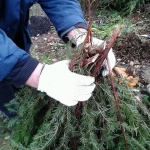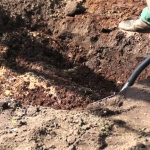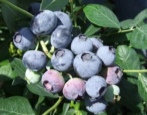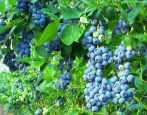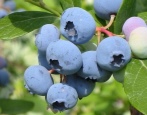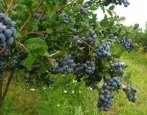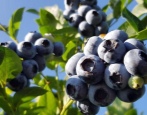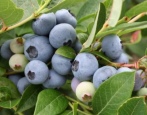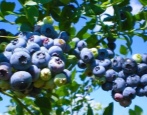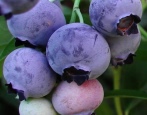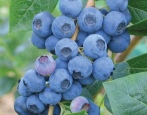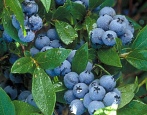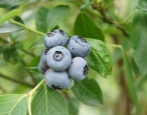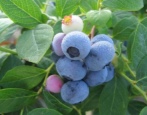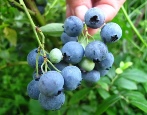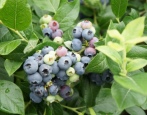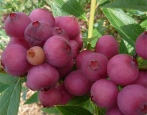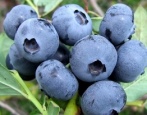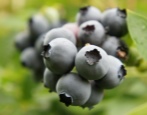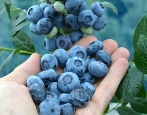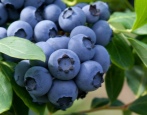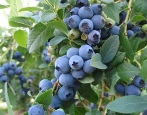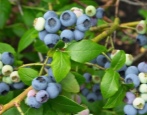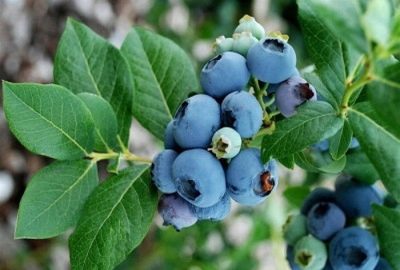
- Ripening terms: mid-early or mid-season
- Growth type: undersized
- Bush height, m: 1,0-1,2
- Taste: good, sweet and sour
- Yield: high
- Average yield: 4-5 kg per bush
- Fruit size: medium
- Fruit shape: rounded, slightly flattened
- Fruit color: blue, with a bluish bloom
- Description of the bush: sprawling
Northland blueberries are grown in large quantities in Canada and America. But if you provide her with good conditions and care, this healthy and tasty berry can grow well in our country. And it is appreciated for its frost resistance and benefits, as well as for decorativeness. The shrub looks great in the garden in spring during flowering, in summer, covered with blue berries, in autumn, when the leaves turn red and decorate everything around.
Breeding history
The name of the blueberry variety Northland (Northland) can be translated from English as "Northern Land". This culture was received at a university base in the US state of Michigan.
In the middle of the last century in America, the problem of creating frost-resistant blueberry varieties for cultivation on an industrial scale was acute. The university has developed a special program for the creation of such varieties. In 1948, under this program, breeding work began on the creation of Northland blueberries. For this, scientists S. Johnston and J. Moulton crossed the tall blueberry culture Berkeley and the 19-H species (undersized blueberry plus the Pioneer seedling). So after these experiments in 1952 the Northland variety appeared, and the official introduction into the culture took place in 1967.
Description of the variety
Blueberries of the described variety are considered undersized. In height, the plant reaches a little more than 1 m. Despite this, the bush looks powerful because of its density, spreading, and produces an abundance of basal growth. The roots of this blueberry are characteristic of the culture: they are superficial, fibrous, there are no hairs on the roots.
Blueberries have straight and upright shoots that are green regardless of the season. The branches of an adult bush are flexible, which allows them not to break from the snow mass.
Smooth, slightly glossy leaves have an oblong shape, their length is 3 cm. In the summer months they are painted in bright green tones, and with the onset of autumn they become fiery red, which makes the bush very effective. American blueberry blooms with small pale pink 5-toothed flowers, resembling a bell in shape.
Fruit characteristics
The berries of the described culture are round, slightly flattened, their size is average, the diameter is from 14 to 16 mm. The color of the skin is in light blue tones, there is a light coating with a bluish bloom. The characteristic scar is dry.
Taste qualities
Blueberries from America have an excellent sweet and sour taste, it is pleasant, complemented by a delicate aroma. Decent and tasting score. The commission assessed the palatability of the fruits on a 5-point scale of 4.0 points.
The purpose of the variety is universal. The fruits of the American berry are very tasty if they are eaten fresh, and they also make tasty and healthy winter preparations (jam, jam, confiture, compote), desserts (jelly, marshmallow). In addition, blueberries keep well dried or frozen.
Ripening and fruiting
Northland blooms in late spring, blooms for a long time (about 3 weeks). The ripening time of the crop is mid-early: the berries ripen after July 15.Fruiting can last until the end of August.
Yield
This American variety is renowned for its high yields. On average, one plant can produce 4–5 kg of berries. And the maximum yield was recorded at 8 kg.
Self-fertility and the need for pollinators
To ensure cross-pollination, which will be needed for the ovaries of berries, it is better to plant not one plant, but 3-4 varieties at once.
Growing and care
Caring for Northland American Blueberries will be easy even for a novice gardener. It is only important to maintain the moisture parameters that are optimal for the culture, as well as the acidity of the soil. It is equally important to carry out the correct feeding of the bush.
The plot on the territory of the garden, where the Northland blueberry planting is planned, is chosen so that it is actively illuminated by the sun, because in the shade this variety is not at all capable of bearing fruit. And also here it is necessary to organize protection from the wind. You cannot plant a crop close to any fruit trees - blueberries will become sour without gaining the required percentage of sugar.
Perhaps the only drawback of this blueberry variety is that it is not drought-resistant. The culture is acutely aware of the lack of moisture, therefore, adherence to the correct watering regime is very important for it. To plant blueberries of this variety, you need:
- prepare a hole 0.5X50X60 cm;
- put drainage;
- add a nutrient mixture;
- place the seedling in the hole, straighten the roots, sprinkle with soil mixture;
- mulch the near-stem circle with a layer of 5–10 cm;
- water the seedling with water.
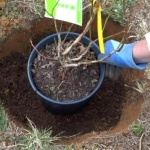
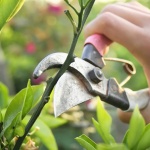
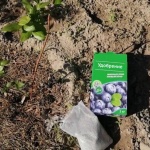
Disease and pest resistance
American blueberries are characterized by fairly decent immunity against attacks by various insect pests and some diseases. For example, it is not subject to berry mummification. However, the plant is rare, but suffers from gray rot, stem cancer, physalosporosis, moniliosis.
Of the harmful insects, the culture suffers from the attacks of aphids, kidney mites, and also the flower beetle. In addition, birds can sometimes feast on blueberry fragrant berries. To preserve the harvest, you can attach strips of plastic film to the branches. It will rustle from the wind, shine and scare away birds.
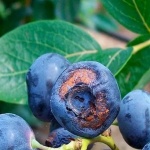
Winter hardiness and the need for shelter
Winter hardiness of the variety is one of its advantages. Northland blueberries often survive freezing temperatures down to -35 °. The flowers of the culture do not withstand very large frosts. The culture was specially developed by scientists for the northern regions of the United States and Canada, therefore it is suitable for cultivation in any cold, harsh climate regions.
